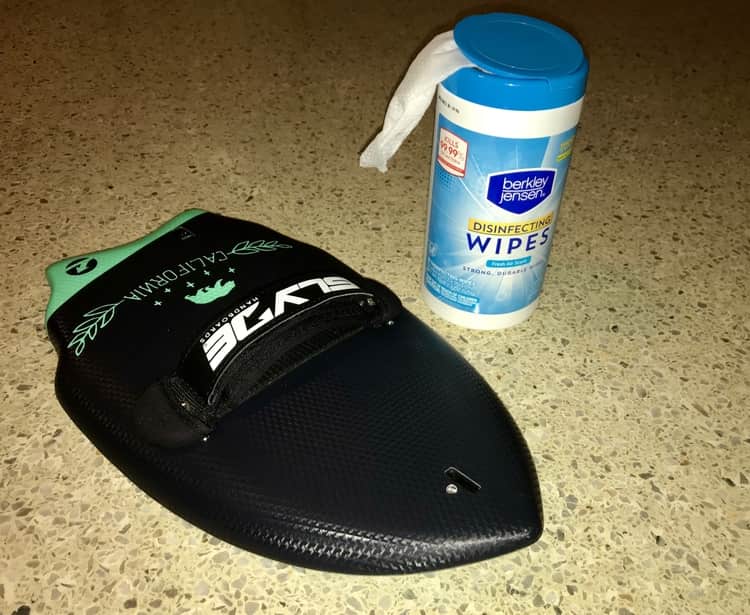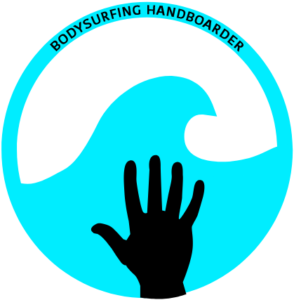Taking care of your bodysurfing handboard is essential to making it last a long time. Keeping it looking brand new is easy to do but you’d be surprised how often people overlook this aspect. Therefore I created this simple bodysurfing maintenance guide as a reminder of how to treat your handboard properly.
How do you take care of a bodysurfing handboard? Here are 11 helpful tips you can implement to increase the lifespan of your handplane:
- Check handboard for dings using the visual touch technique
- Do a high-pressure rinse after every use
- Clean your handboard with a disinfecting wipe
- Don’t let your board sit in direct sunlight or heat for more than 1 hour
- Fix dents or dings immediately with a repair kit
- Store your handboard in cool, padded places
- Carry your handboard vertically when walking
- Transport using a board bag or wrap it in padding
- Avoid bodysurfing near rocks & coral
- Remove wax every 1 – 3 months
- Keep your handboard on a leash
Some of these tips may or may not be new information. I’m sure if you spent a lot of money on your stick, you probably want it to last as long as possible. Implementing these tips will help you increase the lifespan of your board so let’s review how each of these is applied.
Perform a Visual-Touch Handboard Scan
After every bodysurfing session you should always check your board. There are two ways to do this:
- visual scan
- physical touch
The visual scan involves checking all flat surfaces and edges of your handboard using your eyes. Make sure to thoroughly inspect the deck, rails, nose, tail, and underside to observe any damage.
Additionally, you should also run your hand along the edges, deck, and underside of your handboard. Sometimes your eyes don’t catch everything. This is where your sense of touch can help you locate any small dings on your board.
Rinse your handboard with high pressure
You should always rinse your handboard after using. I recommend blasting your board with a high-pressure garden hose. This works well to get sand out of the smallest crevices.
You can also use the outdoor showers near the entrance of the beach. I have found most of these to produce enough water pressure to remove sand and salt from my board.
Salt removal is very important to extend the life of your handboard. Typically, a layer of salt coats your board after using and can cause erosion. Therefore you should not wait too long after bodysurfing to wash it.
I recommend that you remove the handstrap so you can thoroughly rinse the screws, which is where salt and sand usually build up. If the screws rust and corrode then the handstrap can fail.
You should also remove the sand from the screw holes. You can do this with a wire brush and then blast it with water pressure.
Removing the handstrap also allows you to more efficiently rinse out sand and salt from the velcro binding. If sand is not removed from the velcro it can affect the integrity of the adhesion.
Use disinfecting wipes to clean your handboard
Your handboard can be a breeding ground for bacteria. It can often collect dust if it sits in your home for a while. It can capture germs from your friend’s hand if you share it with him or her. The ocean is also home to many organisms that could possibly stick to your handboard.

Using disinfecting wipes is a great way to keep your board clean. They will wipe out any bacteria on the deck of your board to help prevent potential skin irritation or other health issues.
Remember to always clean the underside of your handboard. Removing dirt, wax, and grime from the bottom of your handboard will help to produce the optimal hydrodynamic performance.
Keep your board out of direct sunlight & heat
I have discovered that exposing your handboard to direct sunlight or heat for more than an hour can impact the integrity of your board. It is important to know how heat affects your board, what to look out for, and then how to avoid it.
How does heat affect your handboard?
Resin has a property called glass transition temperature. This is the temperature at which the resin material melts and becomes subject to the following unwanted effects:
- Dry-out: The heat can potentially dry out your handboard and cause cracking.
- Yellowing: UV rays can deteriorate the foam and resin causing separation from coating turning it a yellowish color.
- Delamination: This happens when the coating of your handboard separates from the foam core. The material can expand rapidly under extreme heat causing surface bubbles or peeling.
- Deformation: The heat can cause your board to melt and reshape as it hardens.
*The extreme temperature needed to damage your board can easily be attained, especially if your handboard is a darker color. It will heat up even faster thus compromising your board sooner! Therefore you need to know how to avoid the heat by storing it properly and keeping it covered.
Where to place / store your handboard to avoid heat damage
There are certain places where you should NEVER leave your board. Here is a list of known hot spots that you should avoid:
- Inside the trunk of your car
- Inside your car with the windows rolled up
- In the back of an open pickup truck
- Under direct sunlight on the beach
- In a shed
- In a garage
- Next to heat vents in your home
- Near a fireplace
How to shield your handboard from the heat
In some instances, you will not be able to avoid the heat. For example, spending a day at the beach will leave your board exposed to direct sunlight. What should you do?
In this case, you want to cover your board. This will help to protect against the heat. Here are a few things you can do to provide your handboard with some shade:
- Cover your handboard with a towel
- Cover your handboard with your shirt
- Place your handboard into the carry bag after it dries
- Place your handboard under your beach chair or umbrella
Fix any dents or dings immediately
It is not advisable to wait to fix dings as this can impact the integrity and performance of your handboard. Any tiny cracks can allow the super corrosive saltwater to deteriorate your board so you want to seal those holes up as soon as possible.
There are two ways you can go about fixing your board:
- Take it to a local surf shop and have a professional do it.
- Fix it yourself with a surf repair kit
If you plan on fixing dings and dents on your handboard yourself then you will need to purchase a ding repair kit. These are fairly cheap and you can find them online or at a local surf store. It’s always good to have one of these handy for a quick patch job.
I recommend using either Sun Cure or Solarez repair kit for fixing small dings on your handboard. My good surfer friend from San Diego, CA told me about these products. He has used them to repair many boards.
*FYI…Epoxy resin kits are typically compatible with most foam boards.
If it is your first time repairing a ding, I discovered this video tutorial which provides a good starting point to give you an idea of how to do it. There should also be instructions that come with the repair kit.
Store your board properly
What should you do with your handboard when you are not using it? The way you store your board can impact its integrity. Therefore pay attention to where and how you store your handboard.
If there is one piece of advice to take away from this section, it is to always store your board indoors where it is cool and dry. Keep your handboard out of the rain, sun, and any other type of weather.
It is best practice to keep your handboard inside its carry bag when you are not using it. This way it remains in a padded casing and is protected against dust.
You can also store it on a shelf, in a bin, or even in a drawer because of its compact size. I like to store mine on top of my closet shelf where it rests on a beach towel.

I highly recommend wrapping your board in a towel or placing it on top of a soft surface to protect against potential scratches.
Transport your board carefully
I can not stress how important this is to protect your board during transportation. Usually, the dings that my bodysurfing handboard incurs are not bodysurfing related. It happens when I’m commuting to and from the beach.
I find myself not paying too much attention to my handboard when I’m either walking, driving, or riding my bike with it. I have been guilty of simply tossing my handboard in the trunk of my car without securing it or wrapping it in my beach towel.
Something as simple as turning quickly or hitting a pothole can jostle your board about in your car potentially incurring damage. It is when you are lazy or not paying attention that dings typically happen.
The safest play here is to simply keep it in your handboard carry bag. I wrote an entire article dedicated to how to safely transport your handboard without damaging it so make sure to give that a read before you head out on your next adventure.
Use common sense when bodysurfing
I know this might be common sense but always avoid rocks, coral, and crashing into the shoreline. If you make contact with any of these ocean obstacles you are putting the integrity of your handboard at risk. So be smart and scope out any areas that could potentially harm your handboard and make sure to stay away from that area when bodysurfing.
Take off all wax once a month
Remember to remove wax from your handboard at least once every 1 – 3 months. This is a good practice for maintaining the health of your handboard. Wax can hold dirt, grime, and bacteria. Therefore you should scrape it off as part of your handboard hygiene maintenance protocol.
Wear a leash
It’s a matter of time before your handboard slips from your grip. When it does happen, you want to make sure you are wearing a handboard leash.
This will keep it from the ocean pushing it into coral, smashing it onto rocks, or lodging it in the planks of a pier. Keeping your handboard connected to you at all times will drastically reduce the chances of yours coming in contact with objects that can damage it.
Related Questions:
Can bodysurfing handboards be stored outside?
I do not recommend storing your handboard outside as I mentioned previously in this article. Storing your handboard outdoors exposes it to the elements such as sun, heat, and rain which can deteriorate your board.
How long do bodysurfing handboards last?
Bodysurfing handboard can last for a long time if you know how to take care of it. Check out my article on how long a handboard can last. By implementing some of the tips mentioned in this post you can certainly extend the life of your board.
